
10 Basic Grooming Techniques for Pets
Taking care of your pets goes beyond providing them with food and shelter. Regular grooming is an essential part of keeping your furry friends healthy and happy. Grooming not only helps maintain their appearance but also contributes to their overall well-being. In this article, we will explore ten basic grooming techniques that will help you keep your pets looking their best. From brushing their fur to trimming their nails, we will cover the essential aspects of pet grooming.
Read More: 3 Benefits of Regular Pet Grooming
Brushing and Combing
Regular brushing and combing are vital for maintaining a healthy coat for your pets. It helps remove dirt, tangles, and loose hair while stimulating the skin and distributing natural oils. Different breeds require specific types of brushes, so choose the appropriate one for your pet’s coat. Long-haired pets may need daily brushing, while short-haired breeds can benefit from a weekly session.
Bathing and Drying
Bathing your pets helps keep their skin clean and prevents the buildup of dirt and odors. Use a pet-friendly shampoo and warm water to lather their coat gently. Rinse thoroughly to avoid leaving any residue that could cause skin irritation. After the bath, make sure to dry your pet thoroughly using a towel or a pet dryer. Be cautious when using dryers to prevent overheating.
Ear Cleaning

Cleaning your pet’s ears is an important aspect of grooming, especially for breeds prone to ear infections. Use a veterinarian-recommended ear cleaner and cotton balls to gently wipe away dirt or wax buildup. Avoid using cotton swabs, as they can push debris further into the ear canal and potentially damage the eardrum.
Dental Care
Maintaining good oral hygiene is crucial for your pet’s overall health. Regularly brush your pet’s teeth using a pet toothbrush and toothpaste formulated for animals. This helps prevent dental diseases and keeps their breath fresh. Additionally, providing dental chews and toys can assist in keeping their teeth clean and healthy.
Nail Trimming
Trimming your pet’s nails is necessary to prevent them from becoming too long and causing discomfort or injury. Use a pair of pet nail clippers and be careful not to cut into the quick, which can cause bleeding. If you’re unsure about nail trimming, consult a veterinarian or a professional groomer for guidance.
Anal Gland Expression
Anal glands are located on either side of your pet’s anus and can occasionally become impacted or infected. Regular expression of the anal glands helps prevent discomfort and potential health issues. Consult a veterinarian or a groomer to learn how to express the anal glands properly.
Eye Care
Keeping your pet’s eyes clean is essential for their overall well-being. Use a damp cloth or eye wipes specifically designed for pets to gently remove any discharge or debris around the eyes. If you notice excessive tearing, redness, or swelling, consult a veterinarian for further evaluation.
Haircuts and Trimming

Certain breeds require regular haircuts or trims to maintain a manageable coat length. Consult a professional groomer to determine the appropriate hairstyle for your pet’s breed and lifestyle. Regular trims can help prevent matting and keep your pet cool during hot weather.
Paw Pad Care
Your pet’s paw pads are sensitive and can be prone to dryness or cracking. Regularly check their paw pads for any signs of injury, irritation, or foreign objects. Use a pet-safe moisturizer to keep their paw pads hydrated and protect them from harsh conditions.
Dealing with Shedding
Many pets shed their fur, and it’s important to manage the shedding effectively. Regular brushing helps remove loose hair and prevents it from accumulating in your home. Additionally, a healthy diet, appropriate grooming products, and regular bathing can minimize excessive shedding.
Read More: Grooming Tips for Your Pet During the Summer 2023
FAQs (Frequently Asked Questions)
- How often should I groom my pet? The frequency of grooming depends on your pet’s breed and coat type. Some pets require daily grooming, while others may only need it once a week. Consult a professional groomer or your veterinarian for guidance.
- Can I use human grooming products on my pet? No, it is not recommended to use human grooming products on your pets. They may contain ingredients that can be harmful or irritating to animals. Always use pet-specific grooming products.
- Should I trim my pet’s nails on my own? Nail trimming can be challenging, especially if you’re inexperienced. It’s best to seek guidance from a veterinarian or a professional groomer to ensure the safety and well-being of your pet.
- Why is dental care important for pets? Dental care is vital for pets because it helps prevent dental diseases, such as tooth decay and gum infections. Neglecting dental care can lead to discomfort, pain, and potential health issues.
- How can I reduce shedding in my pet? Regular brushing, a balanced diet, and appropriate grooming products can help minimize shedding in pets. Additionally, maintaining a clean living environment by vacuuming and using pet-friendly cleaning tools can also help manage shedding.
Conclusion
Proper grooming is an essential part of pet care and contributes to their overall well-being. By following these ten basic grooming techniques, you can ensure that your pets look and feel their best. Regular grooming sessions not only help maintain their appearance but also provide an opportunity to bond with your furry companions. Remember to consult a veterinarian or a professional groomer if you have any specific concerns or questions regarding your pet’s grooming needs.







